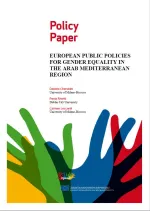European Public Policies for Ender Equality in the Arab Mediterranean Region

SAHWA Policy Paper
ISSN 2564-9167
This paper examines the European Union’s actions to promote gender equality in Arab Mediterranean countries, mainly through the European Neighbourhood Policy (ENP). Considering the relevance given to the topic of gender equality by EU policymakers and the EU’s privileged position as a source of funding for a number of non-state actors as well as governmental agencies in the region, the paper aims to discuss possible mismatches between young people’s needs (as expressed in the survey and fieldwork carried out as part of SAHWA Project) and EU policy priorities and actions. Furthermore, considering the increasingly intra-policy sectors approach of EU policies (O’Connell, 2016), it seems appropriate to focus on the EU’s promotion of gender equality as a lens through which to view youth-related policies as well.
More specifically, the paper is divided into two parts. First, it will examine the scenario that EU policies and policy documents intersect with. Quantitative and qualitative data will be provided on gender relations and the position of women in the Arab Mediterranean countries. In addition to depicting the scenario the EU policies aim to target, building on SAHWA findings (youth survey and ethnographic fieldworks), this first part of the paper will also examine youth awareness of issues related to gender equality (generally high) and of the EU and public interventions in favour of gender equality in the countries considered (generally low).
The second part of the paper revolves around the analysis of EU policy documents relevant to the issue of gender equality. In particular, the selected documents provide guidelines to partner institutions regarding assessments, benchmarks, and suggestions for policy reform. In addition, they offer material for the examination of the main objectives, policy sectors, targets and actors involved in policy implementation. Special attention will be given to the analysis of the paradigms at work when it comes to the way in which gender equality is mainstreamed (gender democracy, gender as a factor for neoliberal economic development) and to the identification and categorisation of the policy targets (e.g. women as vulnerable subjects, as agents of economic and social development). This second part of the paper will then consider all these points as an axis of analysis, depicting the nature, goals and characteristics of EU policy guidelines on gender equality in the region.